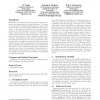4597 search results - page 892 / 920 » The Spider Model of Agents |
GECCO
2008
Springer
13 years 8 months ago
2008
Springer
Modularity and symmetry are two properties observed in almost every engineering and biological structure. The origin of these properties in nature is still unknown. Yet, as engine...
GECCO
2008
Springer
13 years 8 months ago
2008
Springer
The process of creating e-learning contents using reusable learning objects (LOs) can be broken down in two sub-processes: LOs finding and LO sequencing. Sequencing is usually per...
ANOR
2008
13 years 7 months ago
2008
We describe a class of problems motivated by numerous real-world applications where there is a collection of objects that have both a cost and a value, but where some of those obj...
AR
2007
13 years 7 months ago
2007
—Researchers in robotics and artificial intelligence have often looked at biology as a source of inspiration for solving their problems. From the opposite perspective, neuroscie...
CORR
2010
Springer
13 years 7 months ago
2010
Springer
We present a detailed study about the role of the short-cuts of a network in promoting the emergence of cooperation in a population of agents playing the Prisoner's Dilemma Ga...

